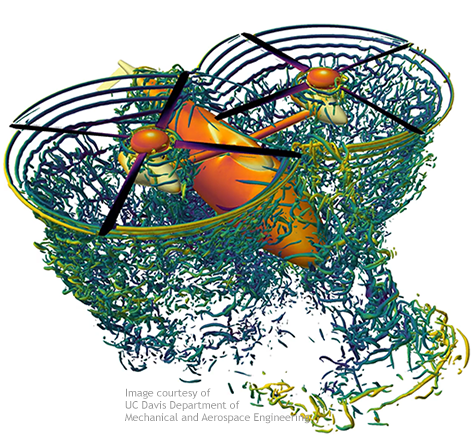
FieldView Benefits
High-end Postprocessing at its Best. The FieldView Postprocessor is the visualization and analysis tool of choice by engineers wanting to make better decisions quickly and with confidence. Our customers know they must deliver accurate results within ever tighter design cycles. CFD Engineers choose FieldView because it enables them to understand, communicate and automate their work.
See What’s New in FieldView 2023
Understand
- See what is happening at realistic (real world) speeds with fast interactive animation.
- Dig deeper with powerful yet easy to use feature extraction tools and predefined Q-criterion and λ2 functions.
- Compare with Dataset Sampling and Dataset Differencing to get quantitative and qualitative differences.
Communicate
- Bring CFD results to life with realistic images and animations that include environments, backgrounds, and materials.
- Increase confidence within your organization and with customers.
- Reveal important new information, make design decisions, avoid problems, and get to market faster.
Automate
- Reuse your work on new simulation results over and over.
- Post-process in full batch with python or FieldView’s own scripting language (FVX).
- Standardize repetitive tasks so any member of the team will get the same great results.
- Perform standard tasks overnight to get the answers you need first thing in the morning.
- Process many more cases than can be done by hand.
- Archive your process with your images, plots, and animations.
FieldView Resources
| Step-by-Step Tutorials » Video Tutorials » Solver Interfaces » FAQs » |
FieldView Blogs » Case Studies » FieldView Image Gallery » |
FieldView Documentation
FieldView documentation includes several components. Each component is downloadable from this page. The tutorials include step-by-step examples for using FieldView and the instructions are part of the FieldView User’s Guide. The datasets corresponding to the tutorials are available for separate download below. New users should review both the How To document and the tutorials of interest. Read about product accessibility in our 508 Compliance document.
Documentation and tutorial files are provided to you under your license to use FieldView. If you are not licensed, or your organization is not licensed, to use or evaluate FieldView, do not download or read these files. You may post them within your organization’s intranet, but they may not be posted on the open internet or distributed in any electronic or printed form. Your cooperation with this is greatly appreciated.
The basic elements of the documentation package are:
- Working with FieldView: This document introduces basic features and controls. The FieldView interface and XDB import are explained here along with descriptions of basic features. Annotated panels show how the interface works for each feature group.
- User’s Guide: The User’s Guide covers FieldView installation, Getting Started, Licensing and Tutorials. Each tutorial will guide you through industry-specific techniques for creating the visualization of your choice. Some of the industries covered include aerospace, turbomachinery, and automotive.
- Reference Manual: The Reference Manual covers FieldView features in more detail. It also includes information on how to automate FieldView (Chapters 4 and 5), how to convert your data into cylindrical coordinates (Chapter 3), how to write files in the FieldView Unstructured format (Appendix D), how to build a User Defined Reader (Appendix D) and how to export data and define color formats (Chapter 1 and appendix E).
- Welcome to FieldView: This document highlights the new features associated with this FieldView release. More detail on the new features are provided in the User’s Guide and Reference Manual.
- Installation Guide: In addition to providing the basic installation instructions for FieldView and the Advanced Technology Viewer, this document provides additional information concerning certified and supported platforms, licensing and post installation tasks such as configuring FieldView Parallel.
- Quick Reference card: a nice tri-fold reminder of the most useful FieldView command line options, environment variables, FVX functions and Script commands. A must-have for all FieldView users!
Or download all the documents above in a single ZIP package: FieldView Documentation Package
Certified and Supported Platforms for FieldView
Certified platforms are defined as follows: The FieldView team has performed a successful, comprehensive test on this platform.
Supported platforms are defined as follows: Users have successfully installed and used the product on this platform.
We strongly recommend that you check whether FieldView will run properly on your operating system BEFORE you attempt to install it. All certified and supported platforms, provided in the following table, are valid on or before November 10, 2023.
Certified & Supported FieldView Platforms
| System | Platform | OS | Client, Server & Parallel |
|---|---|---|---|
| APPLE MAC | INTEL | Big Sur | FV 2023 CERTIFIED |
| Monterey | FV 2023 SUPPORTED | ||
| M1 | Monterey | FV 2023 SUPPORTED (Rosetta 2) | |
| Linux | |||
| CentOS 7 | FV 2023 CERTIFIED | ||
| CentOS 8 | FV 2023 SUPPORTED | ||
| Red Hat Enterprise Linux 6 | FV 2023 SUPPORTED | ||
| Red Hat Enterprise Linux 7 | FV 2023 SUPPORTED | ||
| Red Hat Enterprise Linux 8 | FV 2023 SUPPORTED | ||
| Debian 10 | FV 2023 SUPPORTED | ||
| Debian 11 | FV 2023 SUPPORTED | ||
| Ubuntu 18.04 | FV 2023 SUPPORTED | ||
| Ubuntu 20.04 | FV 2023 SUPPORTED | ||
| Windows | Windows 8 | FV 2023 SUPPORTED | |
| Windows 10 | FV 2023 CERTIFIED | ||
| Windows 11 | FV 2023 SUPPORTED |






